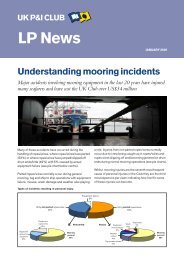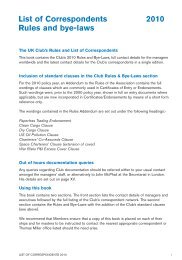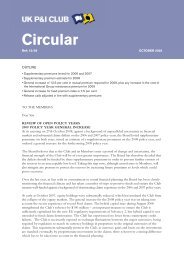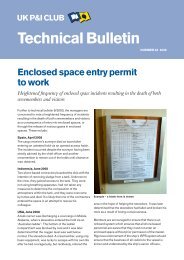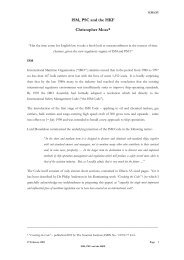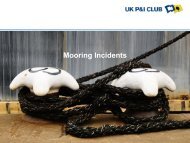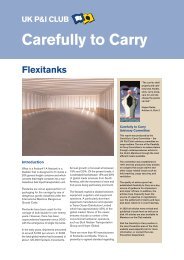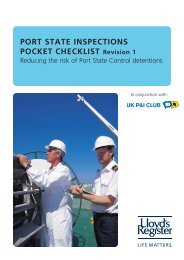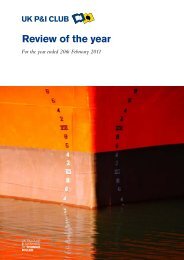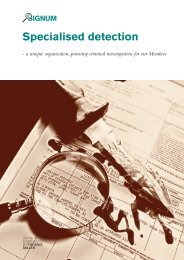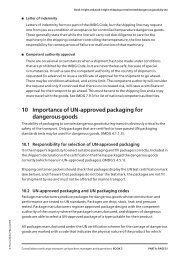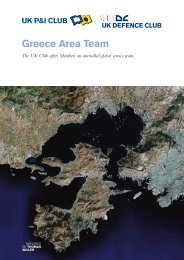Biofuels - UK P&I
Biofuels - UK P&I
Biofuels - UK P&I
Create successful ePaper yourself
Turn your PDF publications into a flip-book with our unique Google optimized e-Paper software.
classed as Pollution Category Z, which means that it is<br />
considered to present a “minor hazard to either marine<br />
resources or human health” if discharged into the sea<br />
from tank cleaning or deballasting operations and<br />
therefore “justifies less stringent restrictions on the<br />
quality and quantity of the discharge into the marine<br />
environment”. Whilst the regulations do not require<br />
ethanol to be carried on a chemical tanker, ethanol is<br />
generally shipped on chemical tankers to maintain the<br />
integrity of the product.<br />
It should be noted at this juncture that the terms<br />
biodiesel and bioethanol do not appear in the IBC<br />
Code. As it is a requirement that the proper shipping<br />
name be used in the shipping document for describing<br />
any product to be carried which appears in the IBC<br />
Code, these terms cannot be used to describe the<br />
products being carried.<br />
The situation becomes somewhat more confusing when<br />
we consider how blends of conventional fossil fuels and<br />
biofuels are shipped, and which Annex of MARPOL they<br />
fall under. MARPOL Annex I covers the prevention of<br />
pollution by oil and MARPOL Annex II covers the control<br />
of pollution by noxious liquid substances carried in bulk.<br />
Blends of biofuels and conventional fuels are essentially<br />
mixtures of mineral oil based hydrocarbons and noxious<br />
liquid substances. At present, the International Maritime<br />
Organization (IMO) Bulk Liquids and Gases subcommittee<br />
are addressing the issue of how to classify<br />
the blends. In the interim, provisional measures are in<br />
place which state that blends of conventional fossil<br />
fuels and biofuels in which the proportion of biofuel<br />
component is less than 15% should be carried under the<br />
provisions of MARPOL Annex I. Blends with a proportion<br />
of biofuel component greater than 15% would have<br />
required the shipper in question to contact an<br />
administrator for a decision on how the product should<br />
be carried. These measures were to remain in place<br />
until July 2009 but have recently been extended until<br />
July 2011 and have been developed to take the form of a<br />
3-band system as follows:<br />
Band 1: 85% or more petroleum oil (15% or less FAME)<br />
– Product is carried as an Annex I cargo. Oil discharge<br />
monitoring equipment (ODME) should be approved/<br />
certified for the mixture carried or tank residues and all<br />
tank washings should be pumped ashore.<br />
Band 2: More than 1% but less than 85% petroleum oil<br />
(15% to 99% FAME) – Product carried as an Annex II<br />
cargo. Blend is treated as tripartite mixture in line with<br />
MEPC.1/Circ.512 but ship type cannot be lower<br />
specification than any component in the blend;<br />
or<br />
Cargo treated as pollution category X, ship type 2 with<br />
worst case minimum carriage requirements assigned<br />
(based on analogous products in the IBC Code such as<br />
pyrolysis gasoline, butyl benzene or the generic entry<br />
for n.o.s. (4) products)<br />
Band 3: 1% or less petroleum oil (Greater than 99%<br />
FAME) – Product carried as Annex II cargo and cargo<br />
treated as the Annex II product contained in the blend.<br />
Issues of concern include the potential effect that<br />
FAME and ethanol cargoes might have on ODME<br />
equipment – it is understood that further testing is<br />
needed to clarify this issue. The varying blend levels<br />
also impact upon how the cargo is measured – work is<br />
currently being undertaken on samples of FAME from<br />
various origins and at different blend levels to establish<br />
suitable volume correction factors (VCFs) to be used in<br />
cargo measurement.




